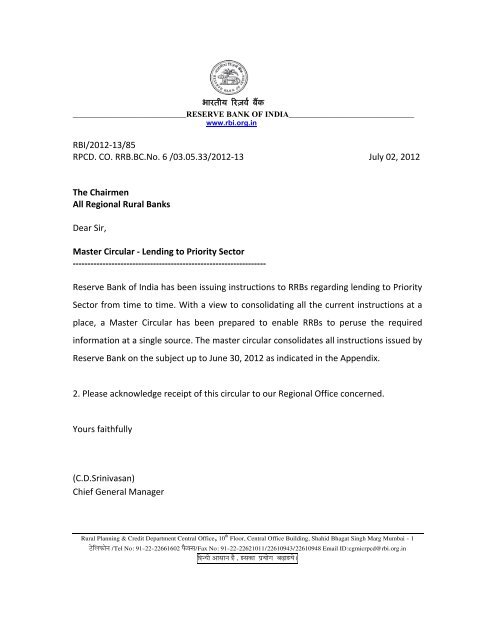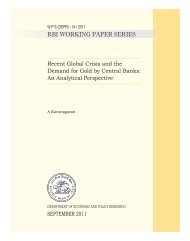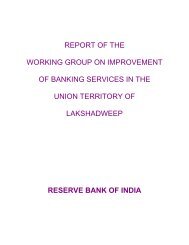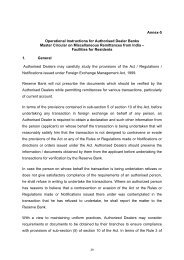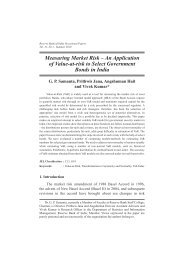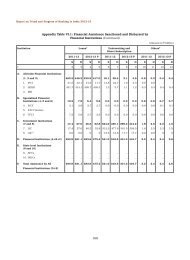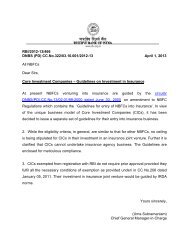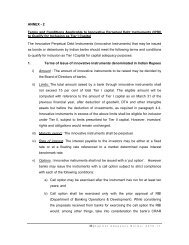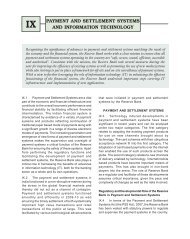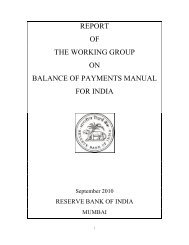RBI/2012-13/85 RPCD. CO. RRB.BC - Reserve Bank of India
RBI/2012-13/85 RPCD. CO. RRB.BC - Reserve Bank of India
RBI/2012-13/85 RPCD. CO. RRB.BC - Reserve Bank of India
You also want an ePaper? Increase the reach of your titles
YUMPU automatically turns print PDFs into web optimized ePapers that Google loves.
भारतीय रज़व बक<br />
____________________________RESERVE BANK OF INDIA_______________________________<br />
www.rbi.org.in<br />
<strong>RBI</strong>/<strong>2012</strong>‐<strong>13</strong>/<strong>85</strong><br />
<strong>RPCD</strong>. <strong>CO</strong>. <strong>RRB</strong>.<strong>BC</strong>.No. 6 /03.05.33/<strong>2012</strong>‐<strong>13</strong> July 02, <strong>2012</strong><br />
The Chairmen<br />
All Regional Rural <strong>Bank</strong>s<br />
Dear Sir,<br />
Master Circular ‐ Lending to Priority Sector<br />
‐‐‐‐‐‐‐‐‐‐‐‐‐‐‐‐‐‐‐‐‐‐‐‐‐‐‐‐‐‐‐‐‐‐‐‐‐‐‐‐‐‐‐‐‐‐‐‐‐‐‐‐‐‐‐‐‐‐‐‐‐‐‐‐‐<br />
<strong>Reserve</strong> <strong>Bank</strong> <strong>of</strong> <strong>India</strong> has been issuing instructions to <strong>RRB</strong>s regarding lending to Priority<br />
Sector from time to time. With a view to consolidating all the current instructions at a<br />
place, a Master Circular has been prepared to enable <strong>RRB</strong>s to peruse the required<br />
information at a single source. The master circular consolidates all instructions issued by<br />
<strong>Reserve</strong> <strong>Bank</strong> on the subject up to June 30, <strong>2012</strong> as indicated in the Appendix.<br />
2. Please acknowledge receipt <strong>of</strong> this circular to our Regional Office concerned.<br />
Yours faithfully<br />
(C.D.Srinivasan)<br />
Chief General Manager<br />
Rural Planning & Credit Department Central Office, 10 th Floor, Central Office Building, Shahid Bhagat Singh Marg Mumbai - 1<br />
’½¹¥¸ûÅø›¸ /Tel No: 91-22-22661602 û¾ÅƬ¸/Fax No: 91-22-22621011/22610943/22610948 Email ID:cgmicrpcd@rbi.org.in<br />
¹−›ú ‚¸¬¸¸›¸ −¾ , ƒ¬¸ˆÅ¸ œÏ¡¸øŠ¸ ¸ õ¸ƒ¡ø—
Lending To Priority Sector ‐ Background<br />
At a meeting <strong>of</strong> the National Credit Council held in July 1968, it was emphasised that<br />
commercial banks should increase their involvement in the financing <strong>of</strong> priority sectors,<br />
viz., agriculture and small scale industries. The description <strong>of</strong> the priority sectors was<br />
later formalised in 1972 on the basis <strong>of</strong> the report submitted by the Informal Study<br />
Group on Statistics relating to advances to the Priority Sectors constituted by the<br />
<strong>Reserve</strong> <strong>Bank</strong> in May 1971. On the basis <strong>of</strong> this report, the <strong>Reserve</strong> <strong>Bank</strong> prescribed for<br />
commercial banks a modified return for reporting priority sector advances and certain<br />
guidelines were issued in this connection indicating the scope <strong>of</strong> the items to be<br />
included under the various categories <strong>of</strong> priority sector. Although initially there was no<br />
specific target fixed in respect <strong>of</strong> priority sector lending, in November 1974 the<br />
commercial banks were advised to raise the share <strong>of</strong> these sectors in their aggregate<br />
advances to the level <strong>of</strong> 33 1/3 per cent by March 1979.<br />
At a meeting <strong>of</strong> the Union Finance Minister with the Chief Executive Officers <strong>of</strong> public<br />
sector banks held in March 1980, it was agreed that banks should aim at raising the<br />
proportion <strong>of</strong> their advances to priority sector to 40 per cent by March 19<strong>85</strong>.<br />
Subsequently, on the basis <strong>of</strong> the recommendations <strong>of</strong> the Working Group on the<br />
Modalities <strong>of</strong> Implementation <strong>of</strong> Priority Sector Lending and the Twenty Point Economic<br />
Programme by <strong>Bank</strong>s (Chairman: Dr. K. S. Krishnaswamy), all commercial banks were<br />
advised to achieve the target <strong>of</strong> priority sector lending at 40 per cent <strong>of</strong> aggregate bank<br />
advances by 19<strong>85</strong>. Sub‐targets were also specified for lending to agriculture and the<br />
weaker sections within the priority sector. Since then, there have been several changes<br />
in the scope <strong>of</strong> priority sector lending and the targets and sub‐targets applicable to<br />
various bank groups.<br />
Regional Rural <strong>Bank</strong>s (<strong>RRB</strong>s)<br />
<strong>RRB</strong>s were originally allowed to lend only to the Target Group comprising small and<br />
marginal farmers, landless labourers, rural artisans and other weaker sections <strong>of</strong> society.<br />
Subsequently, they were allowed to lend up to 60 per cent <strong>of</strong> their incremental lending<br />
during a year to Non‐Target Group borrowers.<br />
After a review, it was decided that from the financial year beginning April 1, 1997, the<br />
advances <strong>of</strong> <strong>RRB</strong>s to Priority Sector borrowers were to constitute 40 per cent <strong>of</strong> their<br />
outstanding advances, as in the case <strong>of</strong> commercial banks. Within the overall target <strong>of</strong><br />
40 per cent, the advances granted to weaker sections <strong>of</strong> society were to constitute 25<br />
per cent <strong>of</strong> the Priority Sector advances (i.e. 10 per cent <strong>of</strong> total outstanding advances).<br />
The levels <strong>of</strong> achievements vis‐à‐vis the prescribed targets as above for lending to<br />
priority sector by <strong>RRB</strong>s were reviewed in the meeting with the Estimate Committee <strong>of</strong><br />
Parliament held on August 6, 2002. With a view to providing more credit to the
segments under priority sector, it was decided that <strong>RRB</strong>s should achieve a target <strong>of</strong> 60<br />
per cent <strong>of</strong> their outstanding advances for priority sector lending as against 40 per cent.<br />
Further, <strong>of</strong> the total priority sector advances, at least 25 percent (i.e. 15 percent <strong>of</strong> the<br />
total advances) were required to be advanced to weaker sections <strong>of</strong> the society. The<br />
revised targets were made effective from the year 2003‐04.<br />
Internal Working Group on Priority Sector Lending<br />
On the basis <strong>of</strong> the recommendations made in September 2005 by the Internal Working<br />
Group (Chairman: Shri C. S. Murthy), set up in <strong>Reserve</strong> <strong>Bank</strong> to examine, review and<br />
recommend changes, if any, in the existing policy on priority sector lending including the<br />
segments constituting the priority sector, targets and sub‐targets, etc. and the<br />
comments/suggestions received thereon from banks, financial institutions, public and<br />
the <strong>India</strong>n <strong>Bank</strong>s’ Association (IBA), it has been decided to include only those sectors as<br />
part <strong>of</strong> the priority sector, that impact large sections <strong>of</strong> the population, the weaker<br />
sections and the sectors which are employment‐intensive such as agriculture, and tiny<br />
and small enterprises.<br />
Accordingly, the broad categories <strong>of</strong> priority sector for <strong>RRB</strong>s will be as under:<br />
I. CATEGORIES OF PRIORITY SECTOR<br />
(i) Agriculture (Direct and Indirect finance): Direct finance to agriculture shall include<br />
short, medium and long term loans given for agriculture and allied activities (dairy,<br />
fishery, piggery, poultry, beekeeping, etc.) directly to individual farmers, Self‐Help<br />
Groups (SHGs) or Joint Liability Groups (JLGs) <strong>of</strong> individual farmers without limit and to<br />
others (such as corporates, partnership firms and institutions) up to the limits indicated<br />
in Section I, for taking up agriculture/allied activities. Indirect finance to agriculture shall<br />
include loans given for agriculture and allied activities as specified in Section I,<br />
appended.<br />
(ii) Micro and Small Enterprises (Direct and Indirect Finance)<br />
Direct finance to micro and small enterprises shall include all loans given to micro and<br />
small (manufacturing) enterprises engaged in manufacture / production, processing or<br />
preservation <strong>of</strong> goods, and micro and small (service) enterprises engaged in providing or<br />
rendering <strong>of</strong> services, and whose investment in plant and machinery and equipment<br />
(original cost excluding land and building and such items as mentioned therein)<br />
respectively, does not exceed the amounts specified in Section I. The micro and small<br />
(service) enterprises shall include small road & water transport operators, small<br />
business, pr<strong>of</strong>essional & self‐employed persons, retail trade i.e. advances granted to<br />
retail traders dealing in essential commodities (fair price shops), consumer co‐operative<br />
stores and advances granted to private retail traders with credit limits not exceeding
Rs.20 lakh and all other service enterprises, as per the definition given in section I<br />
appended.<br />
Indirect finance to small enterprises shall include finance to any person providing inputs<br />
to or marketing the output <strong>of</strong> artisans, village and cottage industries, handlooms and to<br />
cooperatives <strong>of</strong> producers in this sector.<br />
(iii) Micro Credit: Provision <strong>of</strong> credit and other financial services and products <strong>of</strong> very<br />
small amounts not exceeding Rs. 50,000 per borrower, either directly or indirectly<br />
through a SHG/JLG mechanism will constitute micro credit.<br />
(iv) Education loans: Educational loans include loans and advances granted to only<br />
individuals for educational purposes up to Rs.10 lakh for studies in <strong>India</strong> and Rs.20 lakh<br />
for studies abroad, and do not include those granted to institutions. Loans granted to<br />
educational institutions will be eligible to be classified as priority sector advances under<br />
micro and small (service) enterprises, provided they satisfy the provisions <strong>of</strong> MSMED<br />
Act, 2006<br />
(v) Housing loans: Loans up to Rs. 25 lakh to individuals for purchase/ construction <strong>of</strong><br />
dwelling unit per family, (excluding loans granted by banks to their own employees) and<br />
loans given for repairs to the damaged dwelling units <strong>of</strong> families up to Rs. 1 lakh in rural<br />
and semi‐urban areas and up to Rs. 2 lakh in urban and metropolitan areas.<br />
II. OTHER IMPORTANT FEATURES OF THE GUIDELINES<br />
(i) Investments by banks in securitised assets, representing loans to various categories<br />
<strong>of</strong> priority sector, shall be eligible for classification under respective categories <strong>of</strong><br />
priority sector (direct or indirect) depending on the underlying assets, provided the<br />
securitised assets are originated by banks and financial institutions and fulfil the <strong>Reserve</strong><br />
<strong>Bank</strong> <strong>of</strong> <strong>India</strong> guidelines on securitisation. This would mean that the banks' investments<br />
in the above categories <strong>of</strong> securitised assets shall be eligible for classification under the<br />
respective categories <strong>of</strong> priority sector only if the securitised advances were eligible to<br />
be classified as priority sector advances before their securitisation.<br />
(ii) Outright purchases <strong>of</strong> any loan asset eligible to be categorised under priority sector,<br />
shall be eligible for classification under the respective categories <strong>of</strong> priority sector<br />
(direct or indirect), provided the loans purchased are eligible to be categorized under<br />
priority sector; the loan assets are purchased (after due diligence and at fair value) from<br />
banks and financial institutions, without any recourse to the seller; and the eligible loan<br />
assets are not disposed <strong>of</strong>, other than by way <strong>of</strong> repayment, within a period <strong>of</strong> six<br />
months from the date <strong>of</strong> purchase.
(iii) <strong>RRB</strong>s can sell their loan assets held by them under priority sector categories in<br />
excess <strong>of</strong> the prescribed priority sector lending target <strong>of</strong> 60 per cent.<br />
(iv) <strong>RRB</strong>s can issue Inter‐<strong>Bank</strong> Participation Certificates (IBPC) <strong>of</strong> a tenor <strong>of</strong> 180 days on<br />
risk sharing basis to scheduled commercial banks against their priority sector advances<br />
in excess <strong>of</strong> 60% <strong>of</strong> their outstanding advances.<br />
III. TARGETS/SUB‐TARGETS<br />
As at present, <strong>RRB</strong>s will have a target <strong>of</strong> 60 per cent <strong>of</strong> their outstanding advances for<br />
priority sector lending. Further, <strong>of</strong> the total priority sector advances, at least 25 percent<br />
(i.e. 15 percent <strong>of</strong> the total advances) should be advanced to weaker sections <strong>of</strong> the<br />
society.<br />
The detailed guidelines for <strong>RRB</strong>s in this regard are given hereunder:
1. AGRICULTURE<br />
DIRECT FINANCE<br />
Section I<br />
1.1 Finance to individual farmers [including Self Help Groups (SHGs) or Joint Liability<br />
Groups (JLGs), i.e. groups <strong>of</strong> individual farmers, provided banks maintain<br />
disaggregated data on such finance] for Agriculture and Allied Activities (dairy, fishery,<br />
piggery, poultry, bee‐keeping, etc.)<br />
1.1.1 Short‐term loans for raising crops, i.e. for crop loans. This will include<br />
traditional/non‐traditional plantations and horticulture.<br />
1.1.2 Advances up to Rs. 10 lakh against pledge/hypothecation <strong>of</strong> agricultural produce<br />
(including warehouse receipts) for a period not exceeding 12 months, irrespective <strong>of</strong><br />
whether the farmers were given crop loans for raising the produce or not.<br />
1.1.3 Working capital and term loans for financing production and investment<br />
requirements for agriculture and allied activities.<br />
1.1.4 Loans to small and marginal farmers for purchase <strong>of</strong> land for agricultural<br />
purposes.<br />
1.1.5 Loans to distressed farmers indebted to non‐institutional lenders, against<br />
appropriate collateral or group security.<br />
1.1.6 Loans granted for pre‐harvest and post‐harvest activities such as spraying,<br />
weeding, harvesting, grading, sorting, processing and transporting undertaken by<br />
individuals, SHGs and cooperatives in rural areas.<br />
1.1.7 Loans granted for agricultural and allied activities, irrespective <strong>of</strong> whether the<br />
borrowing entity is engaged in export or otherwise. The export credit granted by <strong>RRB</strong>s<br />
for agricultural and allied activities may, however, be reported separately under heading<br />
"Export credit to agricultural sector".<br />
1.2 Finance to others [such as corporates, partnership firms and institutions] for<br />
Agriculture and Allied Activities (dairy, fishery, piggery, poultry, bee‐keeping, etc.)<br />
1.2.1 Loans granted for pre‐harvest and post harvest activities such as spraying,<br />
weeding, harvesting, grading, sorting and transporting.
1.2.2 Finance up to an aggregate amount <strong>of</strong> Rs. one crore per borrower for the purposes<br />
listed at 1.1.1, 1.1.2, 1.1.3 and 1.2.1 above.<br />
1.2.3 One‐third <strong>of</strong> loans in excess <strong>of</strong> Rs. one crore in aggregate per borrower for<br />
agriculture and allied activities.<br />
INDIRECT FINANCE<br />
1.3 Finance for Agriculture and Allied Activities<br />
1.3.1 Two‐third <strong>of</strong> loans to entities covered under 1.2 above in excess <strong>of</strong> Rs. one crore in<br />
aggregate per borrower for agriculture and allied activities.<br />
1.3.2 Loans to food and agro‐based processing units with investments in plant and<br />
machinery up to Rs. 10 crore, undertaken by those other than 1.1.6 above. Credit under<br />
the dairy segment which may primarily benefit small/marginal farmers and tiny units<br />
and may contribute to the development <strong>of</strong> dairy business.<br />
1.3.3 (i) Credit for purchase and distribution <strong>of</strong> fertilisers, pesticides, seeds, etc.<br />
(ii) Loans up to Rs. 40 lakh granted for purchase and distribution <strong>of</strong> inputs for the<br />
allied activities such as cattle feed, poultry feed, etc.<br />
1.3.4 Finance for setting up <strong>of</strong> Agriclinics and Agribusiness Centres.<br />
1.3.5 Finance for hire‐purchase schemes for distribution <strong>of</strong> agricultural machinery and<br />
implements.<br />
1.3.6 Loans to farmers through Primary Agricultural Credit Societies (PACS), Farmers’<br />
Service Societies (FSS) and Large‐sized Adivasi Multi Purpose Societies (LAMPS).<br />
1.3.7 Loans to cooperative societies <strong>of</strong> farmers for disposing <strong>of</strong> the produce <strong>of</strong><br />
members.<br />
1.3.8 Financing the farmers indirectly through the co‐operative system (otherwise than<br />
by subscription to bonds and debenture issues).<br />
1.3.9 Loans for construction and running <strong>of</strong> storage facilities (warehouse, market yards,<br />
godowns, and silos), including cold storage units designed to store agriculture<br />
produce/products, irrespective <strong>of</strong> their location. If the storage unit is registered as SSI<br />
unit/micro or small enterprise, the loans granted to such units may be classified under<br />
advances to Small Enterprises sector.<br />
1.3.10 Advances to Custom Service Units managed by individuals, institutions or
organisations who maintain a fleet <strong>of</strong> tractors, bulldozers, well‐boring equipment,<br />
threshers, combines, etc., and undertake work for farmers on contract basis.<br />
1.3.11 Finance extended to dealers in drip irrigation/sprinkler irrigation system/<br />
agricultural machinery, irrespective <strong>of</strong> their location, subject to the following conditions:<br />
(a) The dealer should be dealing exclusively in such items or if dealing in other products,<br />
should be maintaining separate and distinct records in respect <strong>of</strong> such items.<br />
(b) A ceiling <strong>of</strong> up to Rs. 30 lakh per dealer should be observed.<br />
1.3.12 Loans to Arthias (commission agents in rural/semi‐urban areas functioning in<br />
markets/mandies) for extending credit to farmers, for supply <strong>of</strong> inputs as also for buying<br />
the output from the individual farmers/ SHGs/ JLGs.<br />
1.3.<strong>13</strong> Credit outstanding under loans for general purposes under General Credit Cards<br />
(GCC).<br />
1.3.14 Loans granted to NGOs/MFIs for on‐lending to individual farmers or their<br />
SHGs/JLGs.<br />
1.3.15 Overdrafts, up to Rs.25, 000 (per account), granted against 'no‐frills' accounts in<br />
rural and semi‐urban areas.<br />
1.4 Loans eligible for classification as direct/indirect finance to agriculture<br />
1.4.1 Credit under the Kisan Credit Card would be treated as direct finance for<br />
agriculture.<br />
1.5 Loans not eligible for Classification as Direct / Indirect finance to Agriculture<br />
1.5.1 Loans sanctioned to NBFCs for on‐lending to individuals or other entities against<br />
gold jewellery, investments made by banks in securitised assets originated by NBFCs,<br />
where the underlying assets are loans against gold jewellery, and purchase / assignment<br />
<strong>of</strong> gold loan portfolio from NBFCs.
2 MICRO and SMALL ENTERPRISES<br />
DIRECT FINANCE<br />
2.1.1 Manufacturing Enterprises<br />
(a) Micro (manufacturing) Enterprises<br />
Enterprises engaged in the manufacture / production, processing or preservation <strong>of</strong><br />
goods and whose investment in plant and machinery [original cost excluding land and<br />
building and the items specified by the Ministry <strong>of</strong> Small Scale Industries vide its<br />
notification no. S.O.1722(E) dated October 5, 2006] does not exceed Rs.25 lakh,<br />
irrespective <strong>of</strong> the location <strong>of</strong> the unit.<br />
(b) Small (manufacturing) Enterprises<br />
Enterprises engaged in the manufacture / production, processing or preservation <strong>of</strong><br />
goods and whose investment in plant and machinery [original cost excluding land and<br />
building and such items as in 2.1.1 (a)] is more than Rs.25 lakh but does not exceed Rs.5<br />
crore, irrespective <strong>of</strong> the location <strong>of</strong> the unit.<br />
2.1.2 Service Enterprises<br />
(a) Micro (service) Enterprises<br />
Enterprises engaged in providing / rendering <strong>of</strong> services and whose investment in<br />
equipment (original cost excluding land and building and furniture, fittings and other<br />
items not directly related to the service rendered or as may be notified under the<br />
MSMED Act,2006) does not exceed Rs.10 lakh, irrespective <strong>of</strong> the location <strong>of</strong> the unit.<br />
(b) Small (service) Enterprises<br />
Enterprises engaged in providing / rendering <strong>of</strong> services and whose investment in<br />
equipment [original cost excluding land and building and furniture, fittings and such<br />
items as in 2.1.2 (a)] is more than Rs.10 lakh but does not exceed Rs.2 crore, irrespective<br />
<strong>of</strong> the location <strong>of</strong> the unit.<br />
(c) The small and micro (service) enterprises shall include small road & water transport<br />
operators, small business, pr<strong>of</strong>essional & self‐employed persons, and other service<br />
enterprises engaged in activities, viz, consultancy services including management<br />
services, composite broker services in risk and insurance management, Third Party<br />
Administration (TPA) services for medical insurance claims <strong>of</strong> policy holders, seed<br />
grading services, training‐cum‐incubator centre, educational institutions, training<br />
institutes, retail trade, practice <strong>of</strong> law i.e. legal services, trading in medical instruments<br />
(brand new), placement and management consultancy services, advertising agency and<br />
training centres, etc. and which satisfy the definition <strong>of</strong> micro and small (service)
enterprises in respect <strong>of</strong> investment in equipment (original cost excluding land and<br />
building and furniture, fittings and other items not directly related to the services<br />
rendered or as may be notified under the MSMED Act, 2006) (i.e. not exceeding Rs.10<br />
lakh and Rs.2 crore respectively).<br />
(d) Loans granted by <strong>RRB</strong>s to micro and small enterprises (MSE) (manufacturing and<br />
services) are eligible for classification under priority sector, provided such enterprises<br />
satisfy the definition <strong>of</strong> MSE sector as contained in MSMED Act, 2006, irrespective <strong>of</strong><br />
whether the borrowing entity is engaged in export or otherwise. The export credit<br />
granted by banks to MSEs may, however, be reported separately under heading "Export<br />
credit to micro and small enterprises sector".<br />
2.1.3 Khadi and Village Industries Sector (KVI)<br />
All advances granted to units in the KVI sector, irrespective <strong>of</strong> their size <strong>of</strong> operations,<br />
location and amount <strong>of</strong> original investment in plant and machinery.<br />
Indirect Finance<br />
2.2 Indirect finance to the micro and small (manufacturing as well as service)<br />
enterprises sector will include credit to :<br />
2.2.1 Persons involved in assisting the decentralised sector in the supply <strong>of</strong> inputs to<br />
and marketing <strong>of</strong> outputs <strong>of</strong> artisans, village and cottage industries.<br />
2.2.2 Advances to cooperatives <strong>of</strong> producers in the decentralised sector viz. artisans<br />
village and cottage industries.<br />
3. MICRO CREDIT<br />
3.1 Loans <strong>of</strong> very small amount not exceeding Rs. 50,000 per borrower provided by<br />
banks either directly or indirectly through a SHG/JLG mechanism.<br />
3.2 Loans to poor indebted to informal sector<br />
Loans to distressed persons (other than farmers) to prepay their debt to noninstitutional<br />
lenders, against appropriate collateral or group security, would be eligible for<br />
classification under priority sector.
4. EDUCATION<br />
4.1 Loans granted to individuals for educational purposes up to Rs.10 lakh for studies<br />
in <strong>India</strong> and Rs.20 lakh for studies abroad. Loans granted to educational institutions will<br />
be eligible to be classified as priority sector advances under micro and small (service)<br />
enterprises, provided they satisfy the provisions <strong>of</strong> MSMED Act 2006.<br />
5. HOUSING<br />
5.1 Loans up to Rs.25 lakh, irrespective <strong>of</strong> location, to individuals for purchase /<br />
construction <strong>of</strong> a dwelling unit per family, excluding loans granted by banks to their own<br />
employees.<br />
5.2 Loans given for repairs to the damaged dwelling units <strong>of</strong> families up to Rs.1 lakh in<br />
rural and semi‐urban areas and up to Rs.2 lakh in urban and metropolitan areas.<br />
5.3 Assistance given to any governmental agency for construction <strong>of</strong> dwelling units or<br />
for slum clearance and rehabilitation <strong>of</strong> slum dwellers, subject to a ceiling <strong>of</strong> Rs.5 lakh <strong>of</strong><br />
loan amount per dwelling unit.<br />
5.4 Assistance given to a non‐governmental agency approved by the NHB for the<br />
purpose <strong>of</strong> refinance for construction / reconstruction <strong>of</strong> dwelling units or for slum<br />
clearance and rehabilitation <strong>of</strong> slum dwellers, subject to a ceiling <strong>of</strong> loan component <strong>of</strong><br />
Rs.10 lakh per dwelling unit<br />
6. STATE SPONSORED ORGANIZATIONS FOR SCHEDULED CASTES/ SCHEDULED TRIBES<br />
Advances sanctioned to State Sponsored Organisations for Scheduled Castes/ Scheduled<br />
Tribes for the specific purpose <strong>of</strong> purchase and supply <strong>of</strong> inputs to and/or the marketing<br />
<strong>of</strong> the outputs <strong>of</strong> the beneficiaries <strong>of</strong> these organisations.<br />
7. Weaker Sections<br />
The weaker sections under priority sector shall include the following:<br />
(a) Small and marginal farmers with land holding <strong>of</strong> 5 acres and less, and landless<br />
labourers, tenant farmers and share croppers;<br />
(b) Artisans, village and cottage industries where individual credit limits do not exceed<br />
Rs. 50,000;<br />
(c) Beneficiaries <strong>of</strong> Swarnjayanti Gram Swarozgar Yojana (SGSY) now National Rural<br />
Livelihood Mission (NRLM)
(d) Scheduled Castes and Scheduled Tribes;<br />
(e) Beneficiaries <strong>of</strong> Differential Rate <strong>of</strong> Interest (DRI) scheme;<br />
(f) Beneficiaries under Swarna Jayanti Shahari Rozgar Yojana (SJSRY);<br />
(g) Beneficiaries under the Scheme for Rehabilitation <strong>of</strong> Manual Scavengers (SRMS);<br />
(h) Advances to Self Help Groups;<br />
(i) Loans to distressed poor to prepay their debt to informal sector, against appropriate<br />
collateral or group security.<br />
(j) Loans granted under (a) to (i) above to persons from minority communities as may be<br />
notified by Government <strong>of</strong> <strong>India</strong> from time to time.<br />
In States, where one <strong>of</strong> the minority communities notified is, in fact, in majority, item (j)<br />
will cover only the other notified minorities. These States/Union Territories are Jammu<br />
& Kashmir, Punjab, Meghalaya, Mizoram, Nagaland and Lakshadweep.
Section ‐ II<br />
Common Guidelines for Priority Sector Advances<br />
1. <strong>RRB</strong>s should follow the following common guidelines prescribed by the <strong>Reserve</strong><br />
<strong>Bank</strong> for all categories <strong>of</strong> advances under the priority sector.<br />
2. Processing <strong>of</strong> Applications<br />
2.1 Completion <strong>of</strong> Application Forms<br />
In case <strong>of</strong> Government sponsored schemes such as NRLM, the concerned<br />
project authorities like DRDAs, DICs, etc. should arrange for completion <strong>of</strong><br />
application forms received from borrowers. In other areas, the bank staff<br />
should help the borrowers for this purpose.<br />
2.2 Issue <strong>of</strong> Acknowledgement <strong>of</strong> Loan Applications<br />
<strong>RRB</strong>s should give acknowledgement for loan applications received from<br />
weaker sections. Towards this purpose, it may be ensured that all loan<br />
application forms have perforated portion for acknowledgement to be<br />
completed and issued by the receiving branch. Each branch may affix on the<br />
main application form as well as the corresponding portion for<br />
acknowledgement, a running serial number. While using the existing stock <strong>of</strong><br />
application forms which do not have a perforated portion for<br />
acknowledgement separately given, care should be taken to ensure that the<br />
serial number given on the acknowledgement is also recorded on the main<br />
application. The loan applications should have a check list <strong>of</strong> documents<br />
required for guidance <strong>of</strong> the prospective borrowers.<br />
2.3 Disposal <strong>of</strong> Applications<br />
(i) All loan applications up to a credit limit <strong>of</strong> Rs.25,000 should be disposed<br />
<strong>of</strong> within a fortnight and those for over Rs.25,000, within 8 to 9 weeks.<br />
(ii) All loan applications for Micro and Small Enterprises up to a credit limit <strong>of</strong><br />
Rs.25,000 should be disposed <strong>of</strong> within 2 weeks and those up to Rs.5 lakh<br />
within 4 weeks, provided the loan applications are complete in all respects<br />
and are accompanied by a 'check list'.<br />
2.4 Rejection <strong>of</strong> Proposals<br />
Branch Managers may reject applications (except in respect <strong>of</strong> SC/ST)<br />
provided the cases <strong>of</strong> rejection are verified subsequently by the Divisional /<br />
Regional Managers. In the case <strong>of</strong> proposals from SC/ST, rejection should be<br />
at a level higher than that <strong>of</strong> Branch Manager.
2.5 Register <strong>of</strong> Rejected Applications<br />
A register should be maintained at the branch, wherein the date <strong>of</strong> receipt,<br />
sanction / rejection / disbursement with reasons therefor, etc., should be<br />
recorded. The register should be made available to all inspecting agencies.<br />
3. Mode <strong>of</strong> Disbursement <strong>of</strong> Loan<br />
With a view to providing farmers wider choice as also eliminating undesirable<br />
practices, banks may disburse all loans for agricultural purposes in cash which will<br />
facilitate dealer choice to borrowers and foster an environment <strong>of</strong> trust. However,<br />
banks may continue the practice <strong>of</strong> obtaining receipts from borrowers.<br />
4. Repayment Schedule<br />
4.1 Repayment programme should be fixed taking into account the sustenance<br />
requirements, surplus generating capacity, the break‐even point, the life <strong>of</strong> the<br />
asset, etc., and not in an "ad hoc" manner. In respect <strong>of</strong> composite loans,<br />
repayment schedule may be fixed for term loan component only.<br />
4.2 As the repaying capacity <strong>of</strong> the people affected by natural calamities gets<br />
severely impaired due to the damage to the economic pursuits and loss <strong>of</strong><br />
economic assets, the benefits such as restructuring <strong>of</strong> existing loans, etc. as<br />
envisaged under NABARD's circular NB.162/PCD‐23/<strong>2012</strong> dated June 21, <strong>2012</strong><br />
may be extended to the affected borrowers.<br />
5. Rates <strong>of</strong> Interest<br />
5.1 The rates <strong>of</strong> interest on various categories <strong>of</strong> priority sector advances will be<br />
as per <strong>RBI</strong> directives issued from time to time.<br />
5.2 (a) In respect <strong>of</strong> direct agricultural advances, banks should not compound<br />
the interest in the case <strong>of</strong> current dues, i.e. crop loans and instalments not fallen<br />
due in respect <strong>of</strong> term loans, as the agriculturists do not have any regular source <strong>of</strong><br />
income other than sale proceeds <strong>of</strong> their crops.<br />
(b) When crop loans or instalments under term loans become overdue,<br />
banks can add interest to the principal.<br />
(c) Where the default is due to genuine reasons banks should extend the<br />
period <strong>of</strong> loan or reschedule the instalments under term loan. Once such a<br />
relief has been extended, the overdues become current dues and banks<br />
should not compound interest.
(d) <strong>Bank</strong>s should charge interest on agricultural advances in respect <strong>of</strong> long<br />
duration crops, at annual rests instead <strong>of</strong> quarterly or longer rests, and could<br />
compound the interest, if the loan / instalment becomes overdue.<br />
6. Penal Interest<br />
6.1.1 The issue <strong>of</strong> charging penal interests that should be levied for reasons such<br />
as default in repayment, non‐submission <strong>of</strong> financial statements, etc. has been left<br />
to the Board <strong>of</strong> each bank. <strong>Bank</strong>s have been advised to formulate policy for<br />
charging such penal interest with the approval <strong>of</strong> their Boards, to be governed by<br />
well accepted principles <strong>of</strong> transparency, fairness, incentive to service the debt and<br />
due regard to difficulties <strong>of</strong> customers.<br />
6.1.2 No penal interest should be charged by banks for loans under priority<br />
sector upto Rs.25,000 as hitherto. However, banks will be free to levy penal<br />
interest for loans exceeding Rs.25,000 in terms <strong>of</strong> the above guidelines.<br />
7. Service Charges / Inspection Charges<br />
7.1.1 No service charges / inspection charges should be levied on priority sector<br />
loans up to Rs.25,000.<br />
7.1.2 For loans above Rs.25,000/‐banks will be free to prescribe service charges<br />
with the prior approval <strong>of</strong> their Boards, in terms <strong>of</strong> circular No.<br />
DBOD.Dir.<strong>BC</strong>.86/03.01.00/99‐2000 dated September 7, 1999.<br />
8. Insurance against Fire and Other Risks<br />
8.1 <strong>RRB</strong>s may waive insurance <strong>of</strong> assets financed by bank credit in the following<br />
cases :<br />
No. Category Type <strong>of</strong> Risk<br />
(a) All categories <strong>of</strong> priority sector advances<br />
up to and inclusive <strong>of</strong> Rs.10,000<br />
(b)<br />
Fire & other<br />
risks<br />
Type <strong>of</strong><br />
Assets<br />
Equipment<br />
and current<br />
assets<br />
Advances to Micro and Small Enterprises up to and inclusive <strong>of</strong><br />
Rs.25,000 by way <strong>of</strong> ‐<br />
* Composite loans to artisans, village<br />
and cottage industries<br />
Fire Equipment<br />
and current<br />
assets<br />
* All term loans Fire Equipment
* Working capital where these are<br />
against non‐hazardous goods<br />
Fire Current<br />
Assets<br />
8.2 Where, however, insurance <strong>of</strong> vehicle or machinery or other equipment /<br />
assets is compulsory under the provisions <strong>of</strong> any law or where such a requirement<br />
is stipulated in the refinance scheme <strong>of</strong> any refinancing agency or as part <strong>of</strong> a<br />
Government‐sponsored programmes such as NRLM, insurance should not be<br />
waived even if the relative credit facility does not exceed Rs.10,000/‐ or<br />
Rs.25,000/‐ as the case may be.<br />
9. Photographs <strong>of</strong> Borrowers<br />
While there is no objection to taking photographs <strong>of</strong> the borrowers for purposes <strong>of</strong><br />
identification, banks themselves should make arrangements for the photographs<br />
and also bear the cost <strong>of</strong> photographs <strong>of</strong> borrowers falling in the category <strong>of</strong><br />
Weaker Sections. It should also be ensured that the procedure does not involve<br />
any delay in loan disbursement.<br />
10. Discretionary Powers<br />
All Branch Managers <strong>of</strong> <strong>RRB</strong>s should be vested with discretionary powers to<br />
sanction proposals from weaker sections without reference to any higher<br />
authority. If there are difficulties in extending such discretionary powers to all the<br />
Branch Managers, such powers should exist at least at the district level and<br />
arrangements be ensured that credit proposals on weaker sections are cleared<br />
promptly.<br />
11. Machinery to look into Complaints<br />
11.1.1 There should be machinery at the regional <strong>of</strong>fices to entertain complaints<br />
from the borrowers if the branches do not follow these guidelines, and to verify<br />
periodically that these guidelines are scrupulously implemented by the branches.<br />
11.1.2 The names and addresses <strong>of</strong> the <strong>of</strong>ficer with whom complaints can be<br />
lodged should be displayed on the notice board <strong>of</strong> every branch.<br />
12. Amendments<br />
These guidelines are subject to any instructions that may be issued by the <strong>RBI</strong> from<br />
time to time.
List <strong>of</strong> circulars consolidated by the Master Circular<br />
No. Circular No. Date Subject Paragraph<br />
No.<br />
1 <strong>RPCD</strong>.<strong>CO</strong>.<strong>RRB</strong>.<strong>BC</strong>.<br />
No.74/03.05.33<br />
2011‐12<br />
2 <strong>RPCD</strong>.<strong>CO</strong>.<strong>RRB</strong>.<strong>BC</strong>.<br />
No.24/03.05.33<br />
2011‐12<br />
3 <strong>RPCD</strong>.<strong>CO</strong>.<strong>RRB</strong>.<strong>BC</strong>.<br />
No.71/03.05.33<br />
2010‐11<br />
4 <strong>RPCD</strong>.<strong>CO</strong>.<strong>RRB</strong>.<strong>BC</strong>.<br />
No.82/03.05.33<br />
2009‐10<br />
5 <strong>RPCD</strong>.<strong>CO</strong>.<strong>RRB</strong>.<strong>BC</strong>.<br />
No.76/03.05.33<br />
2009‐10<br />
27.04.<strong>2012</strong> Priority sector<br />
lending‐indirect<br />
finance to Housing<br />
sector<br />
18.10.2011 Inclusion <strong>of</strong> Credit<br />
under KCC under<br />
direct finance for<br />
Agriculture<br />
16.05.11 Increase in Housing<br />
Loan Limit under<br />
Priority Sector<br />
11.05.10 Priority Sector<br />
Lending‐<br />
Export Credit for<br />
Agriculture and<br />
Allied Activities<br />
21.04.10 Priority Sector<br />
Lending –<br />
Advances to Micro<br />
and Small<br />
Appendix<br />
Gist <strong>of</strong> instructions<br />
6.4 Increase in limit from Rs. 5<br />
lakh to Rs. 10 lakh for the<br />
bank loans extended to<br />
non‐governmental<br />
agencies, approved by<br />
NHB for their refinance,<br />
for on‐lending for the<br />
purpose <strong>of</strong><br />
construction/reconstructi<br />
on <strong>of</strong> individual dwelling<br />
units or for slum clearance<br />
and rehabilitation <strong>of</strong> slum<br />
dwellers.<br />
1.4.1 Credit under Kisan Credit<br />
card is to be treated as<br />
direct finance for<br />
agriculture under priority<br />
I.V, 6.1<br />
sector.<br />
Housing loan limits<br />
increased from Rs. 20 lakh<br />
to Rs. 25 lakh<br />
I 1.1.7 Loans granted by <strong>RRB</strong>s for<br />
agricultural and allied<br />
activities are eligible for<br />
classification under<br />
priority sector,<br />
irrespective <strong>of</strong> whether<br />
borrowing entity is<br />
engaged in export or<br />
otherwise.<br />
I 2.1.2 (d) Loans granted by <strong>RRB</strong>s to<br />
MSE (manufacturing and<br />
services) to be eligible for<br />
classification under
6 <strong>RPCD</strong>.<strong>CO</strong>.<strong>RRB</strong>.<strong>BC</strong>.<br />
No.29/03.05.33<br />
2009‐10<br />
7 <strong>RPCD</strong>.<strong>CO</strong>.<strong>RRB</strong>.<strong>BC</strong>.<br />
No.<strong>13</strong>/03.05.33<br />
2009‐10<br />
8 <strong>RPCD</strong>.<strong>CO</strong>.<strong>RRB</strong>.<strong>BC</strong>.<br />
No .33/03.05.33<br />
2007‐08<br />
9 <strong>RPCD</strong>.<strong>CO</strong>.Plan.<strong>BC</strong>.<br />
No.66/04.09.01<br />
2007‐08<br />
Enterprises<br />
engaged in Exports<br />
06.10.09 Priority Sector<br />
Lending –<br />
Categorisation <strong>of</strong><br />
Activities under<br />
Service under the<br />
MSMED Act,2006<br />
04.8.09 Inter‐<strong>Bank</strong><br />
Participations<br />
22.5.08 Increasing<br />
Opportunities for<br />
Flow <strong>of</strong> Credit to<br />
Priority Sector<br />
06.5.08 General Purpose<br />
Credit Cards and<br />
Overdrafts against<br />
'No‐Frills' Account<br />
as Indirect Finance<br />
to Agriculture<br />
under Priority<br />
Sector<br />
I (ii), 2.1.2<br />
( c )<br />
priority sector, provided<br />
they satisfy the definition<br />
contained in MSMED Act,<br />
2006, irrespective <strong>of</strong><br />
whether the borrowing<br />
entity is engaged in export<br />
or otherwise.<br />
<strong>RRB</strong>s to include loans<br />
granted by them in<br />
respect <strong>of</strong> some activities<br />
under Micro and small<br />
(Service) Enterprises<br />
within the priority sector.<br />
Also, there will be no<br />
separate category for<br />
'Retail Trade" under<br />
"priority sector"<br />
II (iv) <strong>RRB</strong>s can issue IBPC <strong>of</strong> a<br />
tenor <strong>of</strong> 180 days on risk<br />
sharing basis to scheduled<br />
commercial banks against<br />
their priority sector<br />
advances in excess <strong>of</strong> 60%<br />
<strong>of</strong> their outstanding<br />
advances.<br />
II (iii) <strong>RRB</strong>s were allowed to sell<br />
loan assets held under<br />
priority sector categories<br />
in excess <strong>of</strong> the prescribed<br />
priority sector lending<br />
I 1.3.<strong>13</strong><br />
1.3.16<br />
target <strong>of</strong> 60 per cent<br />
<strong>RRB</strong>s were advised to<br />
classify 100 percent <strong>of</strong> the<br />
credit outstanding under<br />
GCC and overdrafts up to<br />
Rs. 25,000 (per account)<br />
granted against 'no‐frills'<br />
accounts as indirect<br />
finance to agriculture


